Durga Puja
| Durga Puja | |
|---|---|
|
Durga Puja | |
| Also called | Akaal Bodhan |
| Observed by | Bengalis, Odias, Assamese and Biharis |
| Type | Hindu |
| Celebrations | Family and other social gatherings, shopping and gift-giving, feasting, pandal-visiting, lighting decorations, cultural dance, idol immersion etc. |
| Observances | Ceremonial worship of goddess Durga, temple services |
| Begins |
Sixth day of Ashwin shukla paksha[1] Seventh day of Ashwin shukla paksha (in Bihar) |
| Ends | Tenth day of Ashwina shukla paksha[1] |
| 2016 date | 7 October – 11 October[2] |
| 2017 date | 26 September – 30 September |
| Frequency | annual |
| Related to | Mahalaya, Navratri, Dussehra |
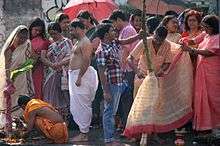
Durga Puja ([d̪urɡa pudʒa], listen: ![]() listen , "Worship of Durga"), also referred to as Dussahara, Durgotsava (Bengali pronunciation: [d̪urɡot̪ʃɔb], listen:
listen , "Worship of Durga"), also referred to as Dussahara, Durgotsava (Bengali pronunciation: [d̪urɡot̪ʃɔb], listen: ![]() Durgotsava , "Festival of Durga") or Sharadotsav is an annual Hindu festival in South Asia that celebrates worship of the Hindu goddess Durga. It refers to all the six days observed as Mahalaya, Shashthi, Maha Saptami, Maha Ashtami, Maha Navami and Vijayadashami.
Durgotsava , "Festival of Durga") or Sharadotsav is an annual Hindu festival in South Asia that celebrates worship of the Hindu goddess Durga. It refers to all the six days observed as Mahalaya, Shashthi, Maha Saptami, Maha Ashtami, Maha Navami and Vijayadashami.
Durga Puja festival is celebrated from the sixth to tenth day of bright lunar fortnight (shukla paksha) in the Bikram Sambat Calendar month of Ashwin.[3] This period falls in the fortnight corresponding to the festival is called Devi Paksha, "Fortnight of the Goddess"). Devi Paksha is preceded by Mahalaya, the last day of the previous fortnight Pitri Paksha, "Fortnight of the Forefathers"), and is ended on Kojagori Lokkhi Puja ("Worship of Goddess Lakshmi on Kojagori (full moon night).
Durga Puja festival marks the victory of Goddess Durga over the evil buffalo demon Mahishasura . Thus, Durga Puja festival epitomises the victory of Good over Evil. In Bengal, Durga is worshipped as Durgotinashini, the destroyer of evil and the protector of her devotees.
Durga Puja is widely celebrated in the Indian states of Assam, Mithila (ancient) region of Nepal and Bihar, Jharkhand, Manipur, Odisha, Tripura, Meghalaya and West Bengal, where it is a five-day annual holiday.[4] In both West Bengal and Tripura, which have a majority of Bengali Hindus, it is the biggest festival of the year. In Assam due to presence of huge number of Bengali Hindus and quite a large number of Assamese Hindus of Shakta sect of Hinduism (Assam is predominantly Vaishnavite Hindu populous state), it is one of the biggest religious festivals, as the biggest festival is Bihu which is secular in nature. Not only is it the biggest Hindu festival celebrated throughout the state, it is also the most significant socio-cultural event in Bengali Hindu society. Apart from eastern India, Durga Puja is also celebrated in Delhi, Uttar Pradesh, Maharashtra, Gujarat, Punjab, Kashmir, Himachal Pradesh, Haryana, Rajasthan, Uttarakhand, Madhya Pradesh, Goa, Telangana, Tamil Nadu, Sikkim, Andhra Pradesh, Karnataka, and Kerala. Durga Puja is also celebrated as a major festival in Nepal where 82% population is Hindu, and in Bangladesh where 10% population is Hindu. Nowadays, many diaspora Assamese and Bengali cultural organisations arrange for Durgotsab in countries such as the United States, Canada, United Kingdom, Australia, Germany, France, The Netherlands, Singapore, Bahrain and Kuwait, among others. In 2006, a grand Durga Puja ceremony was held in the Great Court of the British Museum.[5]
The prominence of Durga Puja increased gradually during the British Raj in Bengal and erstwhile Assam.[6] After the Hindu reformists identified Durga with India, she became an icon for the Indian independence movement. In the first quarter of the 20th century, the tradition of Baroyari or Community Puja was popularised due to this. After independence, Durga Puja became one of the largest celebrated festivals in the whole world. It is also the largest "open Air Art Exhibition in the World".
Durga Puja also includes the worship of Shiva, who is Durga's consort (Durga is an aspect of Goddess Parvati), in addition to Lakshmi, Saraswati with Ganesha and Kartikeya, who are considered to be Durga's children.[7] Worship of mother nature is done, through nine types of plant (called "Kala Bou"), including a plantain (banana) tree, which represent nine divine forms of Goddess Durga.[8] Modern traditions have come to include the display of decorated pandals and artistically depicted sculptures (murti) of Durga, exchange of Vijaya greetings and publication of Puja Annuals.
Names
In Bengal, Assam, Odisha, Durga Puja is also called Akalbodhan(অকাল বোধন) ("untimely awakening of Durga"), Sharadiya Pujo ("autumnal worship"), Sharodotsab (Bengali: শারদোৎসব ("festival of autumn")), Maha Pujo ("grand puja"), Maayer Pujo ("worship of the Mother"), or merely as Puja or Pujo. In East Bengal (Bangladesh), Durga Puja used to be celebrated as Bhagabati Puja. It is also called Durga Puja in West Bengal, Bihar, Assam, Odisha, Delhi and Madhya Pradesh.[9]
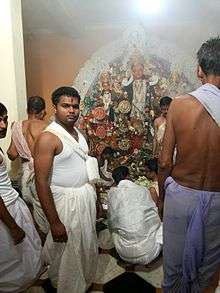
Puja is called Navaratri Puja in Gujarat, Uttar Pradesh, Punjab, Kerala, and Maharashtra,[10] Kullu Dussehra in Kullu Valley, Himachal Pradesh,[11] Mysore Dussehra in Mysore, Karnataka,[12] Bommai Golu in Tamil Nadu and Bommala koluvu in Andhra Pradesh.[13]
Origin of the autumnal ceremony "Sharadiya"
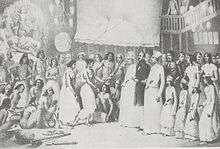
The actual worship of the Goddess Durga as stipulated by the Hindu scriptures falls in the month of Chaitra, which roughly overlaps with March or April and is called Basanti Durga Puja. This ceremony is not observed by many and is restricted to a handful in the state of West Bengal, Assam, Tripura. The more popular form, which is also known as Sharadiya (Autumnal) Durga Puja, is celebrated later in the year with the dates falling either in September or October.[4] Since the Goddess is invoked at the wrong time, it is called "Akaal Bodhon" in Bengali.
One of the earliest evidence of the autumnal celebration can be found in the Tripura Buranji, where it is described that the envoy of the Twipra Kingdom, Rameshwar Nyayalankar, was invited to witness the Durga puja at Rangpur, the capital of the Ahom kingdom, in 1711.[14]
While the most recent revival of the Autumnal worship of Goddess Durga can be traced to revivalist tendencies in the early freedom movement in Bengal, differences remain in the historical reason behind the revival. One school of thought is of the opinion that the first such Puja was organised by Raja Nabakrishna Deb of the Shobhabazar Rajbari of Calcutta in honour of Lord Clive in the year 1757. The puja was organised because Clive wished to pay thanks for his victory in the Battle of Plassey. He was unable to do so in a Church because the only church in Calcutta at that time was destroyed by Siraj-ud-Daulah. Indeed, many wealthy mercantile and Zamindar families in Bengal made British officers of the East India Company guests of honour in the Pujas. The hosts vied with one another in arranging the most sumptuous fares, decorations and entertainment for their guests. This was deemed necessary since the company was in charge of a large part of India including Bengal after the battles of Plassey and Buxar.[15] However, this particular claim has been refuted by the Sovabazar Rajbari. In a public announcement during the Durga Puja of 2011, notice boards were placed at the entrance of the puja, clarifying the Rajbari's official position.
There is also a mythological belief that Lord Ram, who was a Durga worshiper, worshiped Goddess Durga before going to war with Ravana. Rama had performed "Chandi Homa" and invoked the blessings of Durga, who blessed Rama with secret knowledge of the way to kill Ravana. On the day of Ashvin Shukla Dashami, Rama's party found Sita and defeated Ravana. This day is thus also celebrated as Dussehra.
History

The Durga puja has been celebrated since the medieval period, and has evolved and adapted to the world as time passed. A considerable literature exists around Durga in the Bengali language and its early forms, including avnirnaya (11th century), Durgabhaktitarangini by Vidyapati (a famous Maithili poet of the 14th century), but the goddess Durga was not fully integrated into the Hindu pantheon, primarily in Bengal, in the 16th century. Early forms of Durgotsavs (Durga festivals) were primarily private worship in personal residences with the use of musical instruments such as the mridanga, mandira, and smakhya.
According to Archeological evidence from Parashurameshvara Temple built in 6th Century in Bhubaneswar , Odisha says Sadabhula Mahisamardhini Durga being worshiped in Shiva temples .
During the 18th century, the worship of Durga became popular among the land aristocrats of Bengal, the Zamindars. Prominent Pujas were conducted by the zamindars and jagirdars, being enriched by emerging British rule, including Raja Nabakrishna Deb, of Shobhabajar, who initiated an elaborate Puja at his residence. These celebrations brought the Durgostavs out of individual homes and into the public sphere. Festivities were celebrated as a community, where royalty and peasantry were welcomed into the home of the zamindar or bania (merchant) to feast together. The festivities became heavily centred on entertainment — music and female dancers — as well as lavish feasts that continued for the entire month. In the 19th century, the Pujas celebrated placed less emphasis on elaborate celebration and feasting, and more on including all of the community. They moved from being a show of wealth and authority by royalty and merchants back to a festival of worship and community. Many of these old puja exist today. The oldest such Puja to be conducted at the same venue is in Rameswarpur, Odisha, where it has been continued since the last four centuries, starting from the time when the Ghosh Mahashays from Kotarang migrated there as a part of Todarmal's contingent during Akbar's rule. Today, the culture of Durga Puja has shifted from the princely houses to Sarbojanin (literally, "involving all") forms. The first such puja was held at Guptipara — it was called barowari (baro meaning twelve and yaar meaning friends)
Today's Puja, however, goes far beyond religion. Visiting the pandals recent years, one can only say that Durgapuja is the largest outdoor art festival on earth. The music, dancing, and art displayed and performed during the Durga puja played an integral part in connecting the community in Bengal, and eventually across India and the world. In the 1990s, a preponderance of architectural models came up on the pandal exteriors, but today the art motif extends to elaborate interiors, executed by trained artists, with consistent stylistic elements, carefully executed and bearing the name of the artist.
The sculpture of the sculpture itself has evolved. The worship always depicts Durga with her four children, and occasionally two attendant deities and some banana-tree figures. In the olden days, all five sculptures would be depicted in a single frame, traditionally called pata. Since the 1980s however, the trend is to depict each sculpture separately.
From the medieval period up through present day, the Durga puja celebrates the goddess and brings the Hindu community together by integrating modernised aspects of entertainment and technology, while still maintaining the religious worship.[16]
Customs

_%2C_biggest_celebration_of_the_Bengalees.jpg)
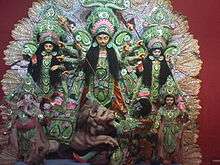
Durga puja mood starts off with the Mahishasuramardini – a two-hour radio programme that has been popular with the community since the 1950s.[17] While earlier it used to be conducted live, later a recorded version began to be broadcast. Bengalis traditionally wake up at 4 in the morning on Mahalaya day to listen to the enchanting voice of the late Birendra Krishna Bhadra and the late Pankaj Kumar Mullick on All India Radio as they recite hymns from the scriptures from the Devi Mahatmyam (Chandi Path).[18]
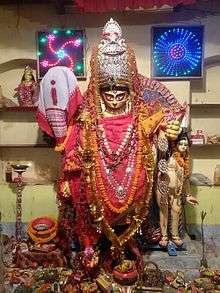
 |
Durga Puja Dhak Sample Sound
A 47 second sample of Dhak playing during Durga Puja. |
| Problems playing this file? See media help. | |
Devi's Aagman (arrival) and Gaman (departure):
It is a popular belief that Devi arrives and departs in some form of transportation which predicts the lives of people for the coming year. There are various forms like Palki, Nouka (Boat), Ashwa(Horse), Gaj (Elephant),etc. each having its own significance. For example, the departure by horse signifies devastation as was the case in early day's after any war. Coming by boat signifies natural gifts like a good harvest.
Somewhere inside these complex edifices is a stage on which Durga reigns, standing on her lion mount, wielding ten weapons in her ten hands. This is the religious center of the festivities, and the crowds gather to offer flower worship or pushpanjali on the mornings, of the sixth to ninth days of the waxing moon fortnight known as Devi Paksha (lit. Devi = goddess; Paksha = period; Devi Paksha meaning the period of the goddess).
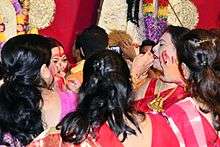
Ritual drummers – dhakis, carrying large leather-strung dhak –– show off their skills during ritual dance worships called aarati. On the tenth day, Durga the mother returns to her husband, Shiva, ritualised through her immersion into the waters[19]–– Bishorjon also known as Bhaashan and Niranjan
At the end of six days, the sculpture is taken for immersion in a procession amid loud chants of 'Bolo Durga mai-ki jai' (glory be to Mother Durga') and 'aashchhe bochhor abar hobe' ('it will happen again next year') and drumbeats to the river or other water body. It is cast in the waters symbolic of the departure of the deity to her home with her husband in the Himalayas. After this, in a tradition called Vijaya Dashami, families visit each other and sweetmeats are offered to visitors (Dashami is literally "tenth day" and Vijay is "victory").
Durga Puja commemorates the annual visit of the Goddess with her children to her parents' home, leaving finally on the Dashami to be re-united with Shiva. This leaving ceremony is symbolised by the immersion of the sculptures on Dashami.[9]
Durga Puja is also a festivity of Good (Ma Durga) winning over the evil (Mahishasur the demon). It is a worship of power of Good which always wins over the bad.
Durga puja mantra
 |
|
| Problems playing this file? See media help. | |
Mantras, the integral part of Durga puja are accompanied by the rhythmic beatings of the dhak, smell of the incense sticks,"ululu ""dhoono", and flowers. These create the atmosphere of Durga puja. Chanting of mantras in Sanskrit is essential part of the Durga Puja festival.[20] This is a part of Durga Puja's Pushpanjali Mantra:
Om Jayanti, Mangala, Kali, Bhadrakali, Kapalini. Durga, Shiba, Kshama, Dhatri, Swaha, Swadha Namahstu Te.Esha Sachandana Gandha Pushpa Bilwa Patranjali, Om Hrring Durgaoi Namah[21]
Durga Slokas (which is also known as Devi Mantra)[22] praises Durga as symbol of all divine forces. According to the sloka, Durga is omnipresent as the embodiment of power, intelligence, peace, wealth, morality etc. A part of Durga Sloka is as follows:[23]
Ya Devi sarva bhuteshu Matri rupena samsthita
Ya Devi sarva bhuteshu Shakti rupena samsthita
Ya Devi sarva bhutesu Shanti rupena samsthita
Namestasyai Namestasyai Namestasyai Namoh Namah
Translation:
The goddess who is omnipresent as the personification of universal mother
The goddess who is omnipresent as the embodiment of power
The goddess who is omnipresent as the symbol of peace
I bow to her, I bow to her, I bow to her
Durga puja mantra and Ashtanayika
In Hinduism whenever a priest worships Goddess Durga, he has to utter a mantra which gives an account of Goddess Durga together with Ashtanayika (her eight eternal playmates). The priest then deeply concentrates his mind upon Goddess Durga together with Ashtanayika (her eight eternal playmates or companions).[24][25][26]
Community or Sarbojanin puja
.jpg)
Initially the Puja was organised by rich families since they had the money to organise the festival. During the late 19th and early 20th century, a burgeoning middle class, primarily in Calcutta, wished to observe the Puja. They created the community or Sarbojanin Pujas.
These Pujas are organised by a committee which represents a locality or neighbourhood. They collect funds called "chaanda" through door-to-door subscriptions, lotteries, concerts etc. These funds are pooled and used for the expenses of pandal construction, sculpture construction, ceremonies etc. The balance of the fund is generally donated to a charitable cause, as decided by the committee. Corporate sponsorships of the Pujas have gained momentum since the late 1990s. Major Pujas in Calcutta and in major metro areas such as Delhi and Chennai now derive almost all of their funds from corporate sponsorships. Community fund drives have become a formality.
Despite the resources used to organise a Puja, entry of visitors into the Pandal is always free. Pujas in Calcutta and elsewhere experiment with innovative concepts every year. Communities have created prizes for Best Pandal, Best Puja, and other categories.
Creation of the sculptures
The entire process of creation of the sculptures (murti) from the collection of clay to the ornamentation is a holy process, supervised by rites and other rituals. On the Hindu date of Akshaya Tritiya when the Ratha Yatra is held, clay for the sculptures is collected from the banks of a river, preferably the Ganges. There is age-old custom of collecting a handful of soil (punya mati) from the nishiddho pallis of Calcutta, literally 'forbidden territories', where sex workers live, and adding it to the clay mixture which goes into the making of the Durga sculpture. After the required rites, the clay is transported. An important event is 'Chakkhu Daan', literally donation of the eyes. Starting with Devi Durga, the eyes of the sculptures are painted on Mahalaya or the first day of the pujas. Before painting on the eyes, the artisans fast for a day and eat only vegetarian food.

Many Pujas in and around Kolkata buy their sculptures from Kumartuli (also Kumortuli), an artisans' town in north Calcutta.[27]
In 1610, the first Durga puja in Kolkata was supposedly celebrated by the Roychowdhuri family of Barisha. Though this was a private affair, community or "Baroyari" Durga puja was started in Guptipara, in Hooghly by 12 young men when they were barred from participating in a family Durga puja in 1761. They formed a committee which accepted subscriptions for organising the puja. Since then, community pujas in Bengal came to be known as "Baroyari" ("baro" meaning "12", and "yar" meaning "friends"). In Kolkata, the first "Baroyari" Durga Puja was organised in 1910 by the "SanatanDharmotsahini Sabha" at Balaram Bosu Ghat Road, Bhawanipur. At the same time, similar Baroyari Pujas were held at Ramdhan Mitra Lane and Sikdar Bagan. The Indian freedom struggle also had an influence on Durga puja in Kolkata.
Environmental impact
Environmental hazards from the materials used to make and colour the sculptures pollute local water sources, as the sculptures are brought directly into the river at the end of festivities. Efforts are underway to introduce eco-friendly materials to the artisans who make the sculptures. West Bengal has been credited by its own environmental agency as being possibly the first Indian State to successfully curb the use of hazardous paints. However, by their own account, only two-thirds of the sculptures made are currently coloured with eco-friendly paints.[28]
Commercialization of Hindu festivals like Durga Puja in the last quarter of 20th century have become a major environmental concern as devout Hindus want bigger and brighter sculptures. Environmentalists say the sculptures are often made from hazardous materials like cement, plastic, plaster of Paris, and toxic paints.[29]
Theme-based pujas and pandals
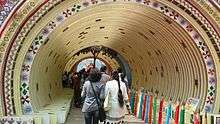
Pandals and sculptures inspired by a particular theme have been the hallmark of many community or Sarbajanin Pujas in Kolkata since the 1990s. Puja committees decide on a particular theme, whose elements are incorporated into the pandal and the sculptures. Popular themes include ancient civilisations like the Egyptians or Incas. Contemporary subjects like the RMS Titanic and Harry Potter have also been the subject in some pandals.
The design and decoration is usually done by art and architecture students based in the city. The budget required for such theme-based pujas is often higher than traditional pujas. They attract crowds and are well received. Inspired by Kolkata, theme-based pandals are becoming popular in cities in neighbouring states, particularly Odisha (see above). Experimentation with the sculptures does not happen much outside Kolkata.
Rapid growth of competitiveness in theme pandals, and also rapid growth of massive billboards that come up at strategic junctions, prior to Puja and allied commercial activities, has also created a cultural backlash from city's traditional Puja pandals, which now claim, "We do not do theme puja, we do Durga puja", according to one hoarding put up in Salt Lake, Kolkata.[30]
2015 saw the extreme hype — the rise and fall of the world's tallest Durga Puja,[31] located at Deshapriya Park. Sponsored by an Indian cement manufacturer, the Puja committee employed artisan Mintu Pal to build a 88 feet tall idol. People visiting this idol came from not just all around the city, but from all around West Bengal, other parts of India and even neighbouring countries like Bangladesh and Nepal. It is reported that over 1 million people[32] tried to view the spectacle on 'chothurthi' and 'panchami', causing a standstill in 10 kilometre radius and a stampede injuring 11 people . Following this, the Kolkata Police stopped the Puja in this location for the next 4 days.
Media attention
TV and radio channels telecast Puja celebrations. Many Bengali/Assamese channels devote whole days to the Pujas. Bengali and Oriya weekly magazines bring out special issues for the Puja known as "Pujabarshiki" or "Sharadiya Sankhya". These contain the works of many writers both established and upcoming and are thus much bigger than the regular issues. Some notable examples are Anandamela, Shuktara, Desh, Sarodiya Anandabazar Patrika, Sananda, Nabakallol, Bartaman[33] All major local news publications are closed on the last day of the festivities.
Movies
- Satyajit Ray's film Joi Baba Felunath is centred on Durga Puja; his movie Nayak has a Durga Puja reference.[34]
- Rituporno Ghosh's Hirer Angti, Utsab and Antarmahal all are centred on Durga Puja.
- The Hindi Devdas interweaves the celebration of Durga Puja into its story line.
- The film Kahaani is centred on Durga Puja and plays a prominent role in the unfolding of events.
- The film Dashami is also centered around Durga puja.
Odisha
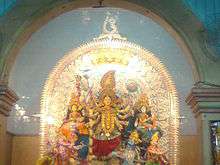

Various accounts exist which ascribe the origin of Durga Puja in the state of Odisha. All historical accounts agree on the influence from other regions although some mythological accounts describe an independent origin.
Durga Puja is a festival, which is observed for 10 days. Odisha, the land of Lord Jagannath, the land of powerful Hindu Kingdom, the land of Gajapati Maharaja's, the royals of Odisha patronage annual Sharadiya Utsav before the state abolition with Republic of India. The Durga Puja is celebrated in two different ways in Odisha. In Shakti peethas (temples of goddess) the Durga Puja is observed with proper rituals for 16 days known as Shodasa/Shohala dinatmaka, which starts from 7 days earlier to mahalaya called as Mulastami(The ashtami with Ardra nakshatra) and ends on Vijayadashami, dussehra. Goddess Durga is also worshipped by devotees in different pandals across the state. The pandals are decorated with beautiful decorative.
According to Markandeya Purana the King of Chedi dynasty Suratha started rituals of Durga Puja during 300B.C. The Chedi dynasty belongs to Kalinga (modern Odisha). Durga Puja has different names in different Puranas and Sastras. In Devi Purana & Kalika Purana it is named as Vijaya Dashami. It is named as Mahaparvana in Devi Mahatmya and Duseehera in Markandeya Purana.
The present form of worship of Durga with earthen sculpture in Odisha was started during the reign of Eastern Ganga King Chodaganga Dev in the 11th century at Puri. The earthen sculpture of Mahishamardini Durga is known as Gosani and the Dussehra fesival is known as Gosani Yatra. It is noteworthy that the co-worship of Mahisamardini Durga with Madhava (Lord Jagannath) is prevalent from the 11th century, Eastern Ganga dynasty period, in Puri.
Before the concept of Sarvajanina Durga Puja started, it was being conducted by princely houses and the first such Puja being conducted anywhere in the world at the same venue and continuing till date is in Odisha. It is at Rameswarpur in Bhadrak district of the state, where it was started about four centuries ago by the Mahashay family who migrated in from Kotarang near Howrah as a part of Todarmal's famous survey of India during Emperor Akbar's rule.
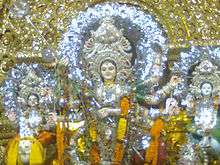
It is said that in the year 1512 to 1517 Chaitanya Deva had come to Cuttack, the capital of Gajapati empire of Odisha and the then emperor of Odisha, Gajapati Pratap Rudra Dev, received him at Gadagadia Ghata situated near the river bank of Mahanadi very close to the kings Palace popularly known as Barabati fort. That year, Sri Chatanya Deva started Durga puja at Binod Bihari temple presently known as Balu Bazar.
The first recorded Sarvajanin Durga Puja in the state is said to have been in the year 1832 in the Kazibajaar area of Cuttack.

A pandal in Odisha is called "Medhaw"(ମେଢ଼ ). For many years, the most expensive installation was the ChaandiMedhaw (Chaandi means Silver) of Choudhuri Bajaar area of Cuttack. The ornamentation was done entirely in silver. A substantial increase in funding has led to the gold plating of the ornamentation. Now it is known as "Suna Medhaw" (Suna means Gold). A few other Pujas in Cuttack now have silver ornaments, too.
The Durga Puja festivities are also prominent in Maa Katak Chandi Temple(କଟକ ଚଣ୍ଡି ). Maa Cuttack Chandi is the presiding deity of Cuttack. The goddess popularly called as Maa Katak Chandi, sits and rules on the heart of the ancient city. She is worshipped as Bhuvaneswari(ଭୁବନେଶ୍ୱରୀ ). Maa Chandi is worshipped in various incarnations of Durga during the puja. In Cuttack, people strongly believe Maa Katak Chandi as 'The Living Goddess'.
The largest Pujas are held in Bhubaneswar, Cuttack, Balasore, Sambalpur, Kendrapara and Rourkela. Shaheed Nagar, Nayapalli, Rasulgarh and Marshaghai of Kendrapara spend the most on the sculptures, decorations, lighting, and other elements.
One reason for the wide acceptance of Durga Puja is the importance of Maa Tarini (ମା ତାରିଣୀ), who is considered one of the embodiments of Shakti in Odia culture. Odisha is home to many important shrines dedicated to the Goddess; great festivities are organised there on Durga and Kali Puja.
It is thus one of the important festivals of Odisha alongside Ratha jatra and the people in Odisha celebrate it on a large scale. The Goddess Durga is among the sacred goddesses of Odisha.
West Bengal
The worship of goddess Durga in the autumn is the year's largest Hindu festival of Bengal. Thousands of pandals are set up in various cities, towns and villages throughout West Bengal. Puja means "worship" and Durga's Puja is celebrated from the sixth to tenth day of the waning moon in the month of Ashvin (Ashshin), which is the sixth month in the Bengali calendar. Occasionally however, due to shifts in the lunar cycle relative to the solar months, it may also be held in the following month, Kartika. In the Gregorian calendar, these dates correspond to the months of September and October. All government offices, schools, colleges, public institutions remain closed for 10 days in Bengal, whereas private sectors and businesses may declare holidays extending from 3–4 days up to a week.
In the Krittibas Ramayana, Rama invokes the goddess Durga battling Ravana. Although she was traditionally worshipped in the spring, due to contingencies of battle, Rama had to invoke her in the autumn akaal bodhan.[35] Today it is this Rama's date for the puja that has gained ascendancy, although the spring puja, known as Basanti Puja [One of the oldest 'sabeki' Basanti Puja is held every year at spring in Barddhaman Pal Bari at Raniganga Bazar, M.K. Chatterjee Road near Karjon Gate], is also present in the Hindu almanac. Another famous portrait of Basanti Puja, can be found in Tangra Rakhal Chandra Das's Bari, which is more than half and a century old. Since the season of the puja is autumn, it is also known as "Sharodia". The pujas are held over a five-day period, which is traditionally viewed as the coming of the married daughter, Durga, to her father, Himalaya's home. It is the most important festival in Bengal, and Bengalis, both devout Hindus and secular persons, celebrate with new clothes and other gifts, which are worn on the evenings when the family goes out to see the 'pandals' (temporary structures set up to venerate the goddess). Although it is a Hindu festival, religion takes a back seat on these five days: Durga Puja in Bengal is also a secular carnival, where people from all backgrounds, regardless of their religious beliefs, participate and enjoy themselves to the hilt.[36]
Kolkata

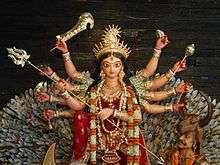
Durga Puja is the most glamourous, most popular and largest festival in Kolkata. No other Indian city celebrates Durga Puja as enthusiastically as Kolkata. In Kolkata and its suburbs more than 4500 pandals are erected, all clamouring for the admiration and praise of the populace.[37] The city is adorned with lights and the vibrant nightlife is the most exciting thing to experience during the Puja. Streets, alleys, parks, houses and trees glitter with fairy lights. Popular movie songs as well as traditional music such as Rabindra Sangeet, 'Chandipath' are played on loudspeakers. Fairs are set up in numerous parks and public spaces, complete with merry-go-rounds, giant wheels and stalls. People from all over the country visit the city at this time, and every night is one mad carnival where thousands of people go 'pandal-hopping' with their friends, relatives and family. Thousands of temporary food-stalls which cater to massive crowds are installed on pavements and roadsides. Traffic comes to a standstill, and indeed, most people abandon their vehicles to travel by foot after a point. A special task force is deployed by Kolkata Police to control law and order. Both Kolkata Municipal Corporation and Government of West Bengal announce special awards for best pujas. Most of the clubs, housing apartments and old zamindar houses organise various cultural and entertainment programmes on the evenings. Many people also come out to join adda at their neighbourhood pandals and festivities continue late into the night. Durga Puja in Kolkata is often referred to as the "Rio Carnival of the Eastern Hemisphere".[38] All throughout Kolkata, or rather, West Bengal, on the last day of Vijaya Dashami, people take earthen lamps called dhunachi which have lighted coconut husks in them and dance the traditional dhunuchi naachh in front of the goddess according to the ceremonial drumbeats(dhak). Married women smear each other with red vermillion powder, which is known as 'sindoor-khela' while exchanges of Bijoya greetings and sweets take place. Then the effigies are paraded through the streets amidst riotous pageantry before being dumped into the rivers.
Siliguri
Hundreds of puja pandals are set up every year in the Siliguri Mahakuma area. The city is adorned with many colourful pandal, glorious "Protima", colourful lighting and sounds. The puja in Saktigarh, Deshbandhu Para, Hakimpara, Rabindra Sangha, Rathkhola, Champashari, Central Colony (N.R.I), Silpanchal (Burdwan Road) and Saktigarh Utjal Sangha, sorojini sangha[shivmandir] are famous and the oldest durga puja in this area.
Silpanchal Durga Puja committee is recognised as one of the oldest puja is town which was established in 1955 and is famous for the "Protima" and many other social activities they undertake during Pujas.
The oldest puja in Siliguri is of Swastika Yubak Sangha. It's one of the most crowd gathering puja of the region. The Puja Committee completed its 50th year of celebrations in 2007. Sorojini sangha completed its 150th year recently.
Cooch Behar

One of the oldest Durga pujas of Bengal. It has been said that this puja was started in 1510, by the founder of Cooch dynasty Raja Biswa Singha in the year of his accession to the throne with the help of his younger brother Sishya Singha.
The gigantic sized Durga sculpture, popularly known as Borodebi (The Great Goddess), made with clay comprises only Maa Durga's image with Mahishasura and Jaya-Bijaya, her consorts excluding her children's sculptures; is vermilion red in colour. As part of tradition, human-sacrifice was offered to the Goddess on the night of Ashtami during a puja attended by the members of the royal family only. In modern times, the ritual is observed in a symbolic form only with a royal family member offering blood-drops. Rituals include sacrificing animals such as buffaloes, goats, pigeons. Not only the royal family, all the people of Cooch-behar regard her as the supreme deity, calling as "Boro-devi" (Supreme-mother).
Badkulla, Nadia
Badkulla is famous in Nadia district for small-scale weaving industry and large pandals during Durga-Puja.During the four days of Durga-Puja Badkulla becomes alive. Every year thousands of people gather here from the nearby places to see the huge pandals, beautiful light works, amazing idols. Once upon a time here Durgapuja was started after getting sound of Cannon from the Royal Palace of Krishnachandra of Krishnagar. Apart from the Durga-Puja, it also well known for its cultural devotion. Here all the clubs organize annual functions to encourage the common people to take participation in different social and cultural events.Laxmi Puja, Rathyatra and Rashyatra is also very famous of here. Some volunteer web-developers of Badkulla has created a website ( www.badkulladurgapuja.net ) of Badkulla Durgapuja to share it with the world.
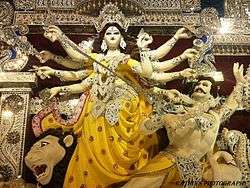
Chanduli, Katwa
One of oldest Durga Puja is held at a village named Chanduli, 12 km from Katwa city, which is more than 350 years old. The Puja is held under the auspices of Mitra bari Debottor estate and here Goddess Durga has two hands visible in place of ten hands. Here, Devi Durga is glorious and famous in this locality. Guptipara
In 1790 First Barwary puja held in this village of West Bengal in the district of Hooghly.[39] Great Goswami family of Dhaka is now at Guptipara led by Satyendra Nath Goswami, Roypara.
Jalpaiguri
Being one of the oldest cities of Colonial Bengal, Jalpaiguri also observed the Durga puja with a great pomp in several places from more than a century. The oldest puja of the town is the Puja of Baikunthapur Rajbari which has started in the sixteenth century by the Raja Shishya Singha, the founder of Raikot kingdom. Kadamtala Durga-bari, Ramkrishna Mission, Jogamaya Kalibari, Samaj Para Sarvajanin Durga puja, Natun para, Panda Para, Tarun Dal, Mohitnagar club, Kalyani Group of Industries' pujas are some of the prominent and significant pujas of the town. Kumari puja in the morning of Ashtami at Ramkrishna Mission Ashram is one of the compulsory place to visit for the inhabitants of the town. More than hundred and seventy Durga pujas are celebrated through all over the town and adjacent suburbs. Some families such as Bagchis, Bhuiyans, Neogys, Guhas are the eminent families who observed Durga Puja in their respective houses from the colonial period. Biswas family of Deshbandhu Para also perform the Puja at their house. They gather every items and ingredients, prescribed in the Kalika Purana for performing the Durga puja. The auspicious chanting of Vedic mantras hymned through the house for all the four days, performed by Shreyan, a member of the family. All the members of the household lend a helping hand in accomplishing the puja successfully. This year the Biswas family also performed Durga Puja, led by Shreyan an accomplished Fashion Designer with full vigor.
Murshidabad and Malda
In Behrampore and also in rural Murshidabad, Durga Puja is a grand affair which celebrates the roots of folk culture as well. In Malda, this festival is celebrated not only by Bengali Hindus but also many tribals and Bengali Muslims are also a part of it. Malda celebrates with pride one of the oldest Durga puja, in a small village, Kaligram, of Chanchal subdivision — The Roy Choudhury Bari's Durga Puja. Its one of the oldest puja celebrated for more than 300 years. The puja starts right from the frist day, i.e., on the day of pratipad, and the puja is celebrated for 10 days. It is one of the most celebrated puja.
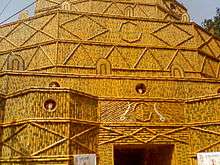
In other parts of India
Assam
After Bihu, Durga Puja is the most popular festival of Assamese community. According to historian Late Benudhar Sarma, the present form of worship of Durga with earthen sculpture in Assam was started during the reign of Ahom King Susenghphaa or Pratap Singha. The King heard about the festivity, the pomp and grandeur with which the King Naranarayan of Koch Bihar celebrated Durga Puja from one Sondar Gohain, who was under captivity of the Koch raja. King Pratap Singha sent artisans to Koch Bihar to learn the art of sculpture making. The King organised the first such Durga Puja celebration in Bhatiapara near Sibsagar.
his was the first time Durga Puja with earthen sculptures in Assam was held for the masses, in addition to the worship in Durga temples like Kamakhya, Digheswari Temple, Maha Bhairabi Temple, Ugrotara, Tamreswari Mandir, etc. Subsequently, similar Pujas were celebrated by other Kings and nobles. Nowadays the Durga Puja is mostly a community festival celebrated in all the cities, towns, villages of Assam with great festivity and religious fervour for five days.Places like Gauhati, Dibrugarh, Lumding, Tinsukia, Mariani, Dhubri, Duliajan, Barpeta, Kokrajhar etc. are also known to celebrate this festival in a grand manner
Durga Puja is the main festival of Hindus in the Bengali dominated Barak Valley of Assam, where Silchar is the main city. In Silchar more than 300 exhibits, known as pandals, decorated with lights, sculptures and other art forms are created. It is said that Durga Puja started in the valley during the rule of Dimasa king Suradarpa Narayan. The festival is popular in other areas of Assam too where ethnic Hindu Bengalis reside.
Bihar

Durga Puja is one of the major festivals in Bihar. Bhagvati Durga Puja and Nou-Durga along with Vijaya Dashami is an important festival of the Maithili Community. Hundreds of pandals are set up with carnivals. The city witnesses a huge surge in visitors in the four days from Maha Saptami up to Vijaya Dashami. More than 1000 exhibits, known as pandals, are set up across the city. Ancient Places of Patna Durga Puja includes Bari and Chhoti Patan Devi, Maa Shitla Mandir Agamkuan etc. Some of the popular puja pandals include New Dak Bungalow Road, Shiv Mandir Khajpura, Shri Krishna Puri, Durga Ashram etc.[40]
Chhattisgarh
Chhattisgarh with 1% Bengali population celebrates Durga Puja at Raipur, Durg, Bhilai, Rajnandgaon, Mahasamund, Dhamtari, Raigarh, Jagdalpur, Chirmiri, Bilaspur, Kanker, Pakhanjore. There are also many devotional places, Where Navratri festival is celebrated twice a year. Each time is celebrated for 9 days. Chaitra Navratri — Vasanta Navratri — Rama Navratri: This navratri is celebrated from first day of Hindu Lunar Calendar, which falls during 1–9th day of Chaitra Month Shukla Paksha. On 9 Navmi, Ram birthday is celebrated so it is also called Rama Navratri. It falls in spring, so it is also called Vasanta Navratri. Vasanta means Spring in Hindi. Maha Navratri — Sharad Navratri Maha Navratri is very famous festival all across India. In Chhattisgarh, it is celebrated with same importance. All famous temples are full of people, new trains are scheduled during this season. In Hindu Calaendar, Maha Navratri is celebrated on 1st to 9th day of Ashwin Month.
Gujarat
After Diwali, Navaratri is the largest Hindu festival celebrated in Gujarat. The festival is devoted to the Goddess Amba mataji. In homes and temples, images of goddess Amba are worshiped in accordance with rituals. Temples dedicated to the Goddess have a constant stream of visitors from morning to night during this period. The most common form of public celebration is the nightly performance of Garba and Dandia Ras throughout the nights of these nine days in public squares, open grounds, streets, private venues and people's homes and courtyards.[41]
Jharkhand

Durga Puja is celebrated with many carnivals. The festival mood starts from Mahalaya, a huge surge in visitors is witnessed during the last four days of the festival, arriving from cities like Jamshedpur (TATA), Ranchi, Hazaribag, Bokaro, Dhanbad, Sisai, etc. After offering puja, thousands of people set out in the evening to have a darshan of pandals. There are also many melas having different stalls, games, etc.
Karnataka
Durga Puja is celebrated in a grand way in this state. In Mysore, Dussehra is easily the most popular festival. Elephants are deckedup with robes and jewellery and taken in processions through the streets of the city. Many people visit Mysore from all over the country to watch this colourful event. There is a floating festival in the temple tank at the foot of Chamundi Hill and a procession of chariots around the temple at the top.
Mysore is named after Mahishasur, the very demon who was slain by the Goddess. The original Indian name was Mahishur. There is a gigantic statue of him on top of the Chamundi hills which is said to be the place where the demon was slain by the Great Goddess.
In recent years due to IT jobs Bengali population has drastically increased in Bangalore. Approximately 4 lakh Bengali people live in Bangalore and over 33[42] places Durga Puja has been organized.[43] The Kanakpura Road Bengali Association (KARBA), The Sarjapur Outer Ring Road Bengali Association[44] organises puja as grand celebration. The oldest of these celebrations remains the Bengali Association Puja at Ulsoor, Bangalore. Durga Pujas in Bangalore is a Sarvajanin program, indicating is open to all. The celebrations include worship, competitions, cultural program, food and adda. Many famous Bangla bands visit these puja associations each year. These pandals also attract variety of food stalls and shopping stalls at the puja fair.
Kashmir
Hindus in Jammu and Kashmir celebrate their festivals with pomp and show. These days, festivities are more subdued. The favourite deities of Kashmir are Lord Shiva and Serawali Ma Durga, the one who rides the tiger. Pundits\Dogris and Muslims alike vouch that Navratri is important. Here each Hindu household does the puja at home. All the adult members of the household fast on water. In the evenings, fruit may be taken. As elsewhere, Dogris grow barley in earthen pots. They believe that if the growth in this pot is good, there is prosperity all year. The most important ritual for Kashmiri Pandits is to visit the temple of guardian goddess Kheer Bhawani on all nine days. On the last day of Navratri, an aarti is held at the temple, after which people break their fast. On Dussehra day, Ravana's effigy is burnt.
Kerala
In Kerala, Durga Puja signifies the beginning of formal education for every child aged 3–5 years. While puja goes on in the temple for all ten days, it is the concluding three days which are most important. Ashtami is the day of Ayudya Puja, when all the tools at home are worshipped. Custom dictates that no tools be used on this day. On navami day, Goddess Saraswati is honoured by worshipping the books and records at home.[45]
Thousands throng the Saraswati temple at Kottayam during this period to take a dip in the mysterious holy pond, whose source is yet unknown. Large gatherings are also seen at the famous temples at Thekkegram (Palghat), in which there are no sculptures, only huge mirrors. A devotee finds himself bowing before his own reflection, which symbolises that God is within us.
Thrikkavu Temple, a famous Durga Devi Temple at Ponnani, Malapuram District of Kerala, is also famous for Navaratri festival and vidyarambham (beginning of formal education). Thousands of children throng this temple on vijaya desami day for vidyarambham. Santhanantha Matom at Mangadu in Kollam observes Navaratri festival with all the religious purity and rituals. On the tenth day, The Vijaya desami, Children perform Vidyarambham here not only for education, but also for various arts and music.
Madhya Pradesh
Madhya Pradesh is a unique state of India where most Hindu festivals are celebrated. Durga Puja is celebrated extensively across the state. Festivities begin with the installation of Durga sculptural representations on the first day of Winter Navaratri and culminate on Vijayadashami Day, also celebrated as Dassehra, the burning of Ravana effigies. During these 10-day festivals (9 days of fasting), pandals decorate the towns and cities and cultural events are organized extensively.
Jabalpur
Jabalpur has been known for its durga puja and dusshera for centuries. The city enjoys the privilege of more than 10,000 idols of Maa Durga. Some major attractions include Maa Sunarhaai, Maa Nunhaai, Vrahad Mahakali Garha Phatak, Siddhi Bala Bose Library Association Club,etc. Themed idols are unique. Artificial temples like Amarnath, Kedarnath, Iskon temples, sangam, etc. are made. Tourist attractions like Disneyland, etc. are, made out of thermocols, Ghost caves, etc. attract the devotees. The idols are accompanied by beautiful lighting and music. On the day of Vijyadashmi many idols are carried in many processions with bands to be submerged. Cultural events like Garba are organised extensively, burning of Ravana, kumbhkarna and meghnath takes place at many places.
Maharashtra and Goa
Nashik boasts of four major ones celebrated by "prabashi" Bengalis' – like the ones at the Government of India Press grounds organised by Nashik Sarbojanin Durga Puja Committee which is the oldest and biggest, the Hindustan Aeronautics Limited (H.A.L)in Ojhar, then the one at Artillery Station,Deolali and one in the industrial area of Satpur-Ambad. In recent years, places such as CIDCO, Rajeevnagar, Panchavati and Mahatmanagar also have set up new mandals.[46]
New Delhi
In 1910, a year before Delhi was declared the capital of British India, the first Sarbojanin (community) puja in Delhi was organised near Kashmiri Gate by a group of expatriate Bengalis, including the doctor Hemchandra Sen. This group became the Delhi Durga Puja Samiti, popularly known as the "Kashmere Gate Puja".[47] The Timarpur puja (near Delhi University) started in 1914.[48] The pujas at Minto Road and Mata Sundari Road started shortly thereafter. By the 1970s, 40 pujas were being held in Delhi[49]
Today, over 800 pujas are held in Delhi, with a few hundred more in Gurgaon and Noida each.[50] By the 1970s, 40 pujas were being celebrated in Delhi, with many theatre troupes performing. Bengali movies would be screened late into the night at many pandals.[49] Today movies have given way to cultural functions, with many of the top kolkata music artistes and other cultural shows being hosted at various delhi pandals. Chittaranjan Park has the highest density of pujas, with nine large 'Sarbojanin' pujas and several family celebrations, and the pandals reflect many Kolkata trends.
Pujas at the New Delhi Kalibari, Chittaranjan Park Kali Mandir, Greater Kailash Kali Mandir and Lajpat Nagar Puja Samity are held in a very traditional manner, following all rituals. Many of the older pujas of Delhi also maintain a traditional style; the one in Kashmiri gate going to bisarjan in a bullock cart as in the days of yore.

A Bengali group under the banner of the Laxmi Nagar Sarvojanin Durga Puja Samiti has been organising Durga Puja in Laxmi Nagar area of New Delhi every year since 1970. The Durga Puja celebrations accompanied by cultural programs like drama, dance, musical competition, drawing painting, and quiz.
Punjab
People of Punjab strictly observe Navaratri. Some Punjabis have only milk for seven days before breaking the fast on ashtami or navami. They worship Durga Ma and do the aarti at home. Some of them have fruit or a complete meal only once a day. Intoxicating drinks or meat, and other forms of entertainment are completely avoided. At the end of the fast, devotees feed beggars or worship little girls who spell the Shakti of the Mother Goddess.
Tripura
Durga Puja is Celebrated in the state of Tripura with all its pride and glory. In India Durga Puja is the second biggest celebrated in this state and also the biggest celebrated festival to the people of Tripura. Particularly, in the Capital city of Agartala. Population living in Here are ethnically 70% Bengali and religiously 86% Hindu, Therefore, making it suitable for the Puja to be the single most important festival in the state. Mainly the pujas are held in various 'paras' which have their own local clubs organising the yearly pujas. The best puja is in Agartala- Like Central Road Yuva Sangstha, Shanti kami, Shantipara, Usha Bazar, Badharghat, Pole Star, Milan Sangha, Haradhan Sangha, Lalbahadur Club, Modern Club, Ramthakur Sangha, Netaji Play Centre etc. usually the clubs organise various cultural Shows to attract highest number of visitors to their pandals and also indulge in a friendly competition amongst themselves. the main centre for 'Visharjan' is the Dashamighat area of the city. Since the Hindu-Bengali ethnicity is maximum here, Durga puja is the most widely celebrated in this state of Northeastern Part of India. A long decades passed since the Bengalis had migrated to this state and established a much better developing area along with the different tribes of the people of the state, from that very beginning point of time Durga puja enhanced and had flown experiencing in a better view.
Other cities where the puja takes place include Amarpur, Udaipur, Belonia, Kumarghat, Santir bazar, Sabrum, Dharmanagar.
Andhra Pradesh
Durga Puja is celebrated in the state of Andhra Pradesh at Vijayawada, Proddatur, Nandyal, Warangal and Hyderabad with all its pride and glory. The Durga temple in Vijayawada is located adjacent to Krishna River and near to Prakasham Barrage is the largest and famous temple in Andhra Pradesh. In Rayalaseema region, The Dasara celebrations in Proddatur stands 2nd place after mysore in South India. In Nandyala and Kurnool, Dasara is one of the biggest festival along with Ugadi. People buy new clothes and things for home. The Durga temple in Warangal is located adjacent to Badrakali Lake located in Center. The distance from Vijayawada to Hyderabad is 280 km and also from Vijayawada to Tirupati (Loard Venkateswara or Balaji) temple is about 320 km. This temple is one of the biggest devotees place in South India. In Hyderabad, Durga Puja is being celebrated for more than 60 years now. Apart from the few minor Durga Pujas; there are 6 major Bengali associations that celebrate the Durga puja across the city. They are the 75 year old Hyderabad Bangalee Samity, the 51 year old Bangiya Sanskritik Sangha, Bengali Cultural Association, Cyberabad Bengali Association, Hyderabad Kalibari and the Bangali Sankritik Sangha.
Tamil Nadu
In Tamil Nadu, Golu is the festival celebrated during the Navaratri period. On this occasion dolls, predominantly that of the Gods and Goddesses from Hindu Tradition are artistically arranged on a seven stepped wooden platform. Traditionally, 'marapachi' wooden dolls representing Perumal and Thayaar are also displayed together at a dominant location on the top step of the platform erected specially for the occasion. On the 9th day (Navami day), Saraswati puja is performed when special prayers are offered to goddess Saraswati – the divine source of wisdom and enlightenment. Books and musical instruments are placed in the puja pedestal and worshipped. Also, tools are placed for the Ayudh puja. Even vehicles are washed and decorated, and puja performed for them on this occasion. As part of the Golu festival, Saraswati puja is performed as Ayudh puja. This is followed by the Vijayadashami celebrations at the culmination of the ten-day festivities. Apart from the golu pooja, Ayudah Puja has become very popular when business houses celebrate it ardently
Bangladesh
Being the largest religious festival for Bengali Hindus, Durga Puja celebrations span throughout Bangladesh with thousands of pandals being set up in various villages, towns and cities. Durga Puja is a grand cultural celebration not only in Dhaka, but also in Netrokona, Sylhet, Mymensingh, Dinajpur, Khulna, Jessore, Barisal, Comilla and Chittagong. Major pujas of Dhaka are held in Dhakeswari Temple, Joykali Temple and Ramkrishna Mission. Special boat race on Buriganga river is arranged. Effigies are paraded through the streets of Shankhari Bazaar of Old Dhaka in loud, colourful processions before being immersed into the rivers. Thousands of Muslims take part in the secular part of festivities in celebration of Bengali solidarity and culture. A five-day holiday is observed by all educational institutions, while Bijoya Dashami is a national holiday.
Other countries
.jpg) Boron - pronam_just_before_Bijaya, Muscat – Durga Puja, Muscat 2015 at Shiva Temple
Boron - pronam_just_before_Bijaya, Muscat – Durga Puja, Muscat 2015 at Shiva Temple After Bijaya - Durga Puja, Muscat 2015 at Shiva Temple
After Bijaya - Durga Puja, Muscat 2015 at Shiva Temple- Durga Puja, Muscat – 2011 at Shiva Temple
- Durga Puja Gathering in Muscat – 2011
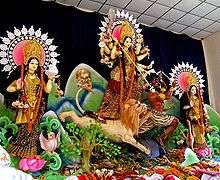 Durga Puja celebrations in Dhakeshwari National Temple, Dhaka, Bangladesh.
Durga Puja celebrations in Dhakeshwari National Temple, Dhaka, Bangladesh.- Durga Puja in Köln (Cologne), Germany.
- Durga Puja in Singapore, October 2010
 Durgapuja, Kolabagan, Dhaka, Bangladesh
Durgapuja, Kolabagan, Dhaka, Bangladesh Celebrations during Durga Puja in Delhi
Celebrations during Durga Puja in Delhi Durga Puja, 2016, in Zurich, Switzerland.
Durga Puja, 2016, in Zurich, Switzerland.
Durga Puja is celebrated by the Indian and Bangladesh's Bengali Hindu diaspora residing in different parts of the world. It is also celebrated in regions and by people culturally and historically distinct from India.
United Kingdom
Bengalis and Assamese people from various states of India and Bangladesh migrated to the UK from the early 1960s and contributed as doctors, engineers and skilled work force. They brought with them the spirit of Puja, and Durga Puja is celebrated all over UK with much gusto and enthusiasm. From north of UK, to South there are scores of Durga Pujas, which are widely celebrated for over a week. The celebration includes not only the Bengalis but many other Hindus as well, as it coincides with Navaratri, where a large population from Gujarat take part in the celebration. This includes famous Gurba community dance, culminating in to Dashera festival.
Amongst the noteworthy Pujas in London, London Sharad Utsav Puja hosted at Ealing Town Hall has attracted London's Bengalis due to jovial atmosphere, well organised cultural programs by renowned artists, and excellent food arrangements. Other prominent Pujas in London include Wembley, organized by Mukherji family, who has been conducting Puja for last 40 odd years, Camden Puja — sponsored by L. Mittal, Hounslow Puja (new), Panchamukhee (Harrow) Puja, Sanaton Puja, Eastham Puja . It is worth considering other major Pujas across the country which includes, Liverpool (45 years old Puja), Glasgow, Cardiff, Leicester, Southampton, Manchester and Birmingham. Every year UK sees new Pujas cropping up, reflecting the true spirit of Bengali culture abroad. On an average, London sees at least 5 new Durga Pujas being started every year. They attract many artists from India and Bangladesh to keep up the spirit through various cultural performances. The Pujas also attract a lot of media channels both UK and India for a wide spread coverage.
China and Hong Kong
In 2004, a group of Indians residing in China came together and organised Durga puja in Shanghai. Since then it has become an yearly affair and has got bigger with active participation from the Indian, expat and the Chinese community. The sculpture of Maa Durga has been brought in from Kumartuli. Every year purohit from India is flown in to perform the puja. Elaborate decoration are done at the venue to give a very distinct look of a pandal interior. Men, women and children turn up in traditional Indian dress at the event. Dhaks are played and Dhunuchi dances are performed. Bhog is served to all guests.
The evenings are occupied with community cultural program and performance from visiting overseas artist. The event receives a fair bit of support from personal and corporate sponsors.
In the recent past, Durga Puja celebrations and festivities were also started in Hong Kong by the Bengali diaspora residing there and the festival is now fast gaining momentum and popularity even in Hong Kong.[51][52]
Nepal
Dussehra in Nepal is called Dashain.[53] Nepal is the country where maximum Hindu lives according to percentage around the globe, the pattern and dates of the festivals coincide with those of India. It is the longest and the most auspicious festival in the Nepalese annual calendar, celebrated by Nepalese people throughout the globe. It is not only the longest festival of the country, but also the one which is most anticipated. The festival falls in September or October, starting from the shukla paksha (bright lunar fortnight) of the month of Ashvin and ending on purnima, the full moon. Among the 15 days for which it is celebrated, the most important days are the first, seventh, eighth, ninth and the tenth.[53]
Throughout the country Shakti is worshiped in all her manifestations. This festival is also known for its emphasis on the family gatherings, as well as on a renewal of community ties.[53] People return from all parts of the world, as well as different parts of the country, to celebrate together.[53] All government offices, educational institutions and other offices remain closed during the festival period.
United States
Durga Puja is organised by communities of Bangladeshis and Indians in the United States. It is observed in all 50 states. In some states like New York, New Jersey, California, Texas etc. between 25 and 40 pujos are organized. Some of the notable pujas are: Houston Durga Bari, Kallol, Garden State Puja Committee (GSPC),[54] Plainfield;[55] Bharat Sevasram and Ananda Mandir in New Jersey; Prabasi in the San Francisco Bay Area,[56] Antorik in Dallas.[57] Some of these pujos attract huge crowds numbering over a thousand people.
Houston Durga Bari's Puja is one of the largest in North America — held on their six-acre temple facility with temple, auditorium, Kala Bhavan, fairs and Vegas-style lighting, right beside a lake. From Bodhon to Bishorjan, we follow the strictest code of rituals – growing nine different plants for nine forms of Durga for Kala Bau, chanting all the chapters of Chandi, performing Sandhi Puja with 108 lotuses and lighting 108 lamps, Hom with 5 priests chanting Chandi on Navami Day. An unbelievably complex set of rituals performed with utmost devotion, helped by dedicated group of volunteers, who prepare the elaborate Naibidya, Bhog and Dadhikarma. It won the first Biswa Bangla Sharad Samman in the International category and was awarded the prize by the Chief Minister of Bengal on 25 November 2015. (www.durgabari.org)
Europe
Durga Puja is organised by communities of Bangladeshis and Indians in Europe. Although pandals are not constructed, the sculptures are flown in from Kumartuli in Kolkata. The desire by the diaspora peoples to keep in touch with their cultural ties has led to a boom in religious tourism, as well as learning from priests or purohits versed in the rites. From 2006[58] the immersion of the Durga sculpture has been allowed in the Thames river for the festival which is held in London.
In Germany several Durga Pujas are celebrated along with Bhog distribution and Anjali in Bremen, Berlin (over 40 years old), Frankfurt(Main), Hamburg, Köln (Cologne), Stuttgart and Munich (München).
In France, the Sammilani association has been celebrating Durga Puja in Paris for 28 years (as of 2014), for the whole five days of Mahashashti to Mahadashami. This festival, which includes diverse cultural programmes, is the social epicentre of Bengali Hindus in France and a major attraction for all others interested in Bengali and Indian culture.
In Switzerland, the 'Swisspuja'[59] group based in Baden, Aargau, in northern Switzerland, has been celebrating Durga Puja since 2003. Currently, the five-day long festival is celebrated with full grandeur at Langnau am Albis, Zurich, with people from all over Switzerland and the rest of Europe. There is a Durga Puja organised by the Centre Vedantique in Geneva as well.
Australia
In Australia, the major Durga Puja festival are held in Sydney along with Melbourne and Brisbane. Two pujas are held every year in Brisbane in pomp and grandeur They are also held very grandly in Perth, the capital of Western Australia. Bhog Distribution, Cultural Programmes, anjali and dhunuchi naach were the main events. BANSW, BPCSV and BPCS are the main organizers in Sydney Melbourne and Brisbane respectively.
Indonesia
Although Durga Puja is not a major festival among the Hindus in Bali and Tengger, the Sindhi and South Indian community have constructed many Maa Durga temples in Jakarta and Tangerang, where Durga Puja is a major celebration here. Sindhis end their Durga Puja on the Ashtmi Day, marked by Havan and Nyari Seva (feeding food to young girls) while South Indians continue till the 10th day. On these days garba and dandia events are also held which ends with a grand celebration of Dassera, where images of Ravan are burned in the Shiva Mandhir, the largest Mandhir in Jakarta.
South East Asia
In Malaysia and Singapore, the Malaysian Bengalee Association and the Bengali Association of Singapore celebrate Durga Puja with Bhog distribution and Anjali along with cultural programs every year.[60]
Animal sacrifice
Animals are sacrificed by Hindus during Durga-puja, mainly at temples of Goddess such as Bhavani or Kali.
A book published 1871 by Pratap Chandra Ghosha gives full description of the rituals involved in animal sacrifice during Durga Puja[61]

The Rajput of Rajasthan offer a sacrifice of buffalo or goat to their family goddess (Kuldevta) during the festival of Navaratri.[62] The ritual requires slaying of the animal with a single stroke. In the past this ritual was considered a rite of passage for young men. The ritual is directed by a Brahmin priest.[63]
Animal sacrifice is practiced in some Eastern states of India and Nepal during Durga Puja.,[64][65] The Hindu temples and houses in Assam, West Bengal and Nepal where it takes place involves slaying of goats, buffaloes and hens.[64][66] A number Tantric Puranas specify the ritual for how the animal should be slayed. In Bengal, a priest recites the Gayatri Mantra in the ear of animal to be sacrificed, in order to free the animal from the cycle of life and death.[67] In Orissa, animal sacrifice is offered to Durga in the form of Chandi during Durga Puja.[64][68]
At the Jagannath temple in Puri, Orissa, goats are sacrificed to the Goddess Bimla during the eighth and ninth day of the Durga festival.[69][70]
See also
References
- 1 2 "Durga Puja Tithi and Timing". Retrieved 17 July 2012.
- ↑ Durga Puja Calendar. durga-puja.org
- ↑ About Durga Puja - Durgotsav
- 1 2 Parmita Borah (2 October 2011). "Durga Puja – a Celebration of Female Supremacy". EF News International. Archived from the original on 25 April 2012. Retrieved 26 October 2011.
- ↑ "Culture24.org.uk". Culture24.org.uk. Retrieved 2013-06-25.
- ↑ "Durga Puja".
- ↑ Kinsley, David (1988). Hindu Goddesses: Vision of the Divine Feminine in the Hindu Religious Traditions. University of California Press. ISBN 0-520-06339-2. p. 95.
- ↑ "Kolabou". Bangalinet.com. Retrieved 2013-06-25.
- 1 2 "Durga-puja.org". Durga-puja.org. 2012-10-06. Retrieved 2013-06-25.
- ↑ Navratri Puja, Durga-puja.org
- ↑ Kullu Dussehra, Durga-puja.org
- ↑ Mysore Dussehra, Durga-puja.org
- ↑ "Bommai-kolu", Durga-puja.org
- ↑ "The Tripura envoys stayed on for some time at Rangpur to witness the celebrations of the Durga Puja. On the Ashtami day Rameswar Nyayalankar was invited to engage in a dialectical contest with the Assamese pundit Jaygopal. King Rudra Singha, however, interposed and ended the discussions on the ground that Rameswar had come to Assam as diplomatic agent and not as a Pundit or a Brahman." S K Bhuyan (1938) Tripura Buranji, Govt of Assam, Gauhati, pxiii.
- ↑ "Raja Nabakrishna Deb and Durga Puja". Retrieved 2 October 2011.
- ↑ Tithi Bhattacharya (November 2007). "Tracking the Goddess: Religion, Community, and Identity in the Durga Puja Ceremonies of Nineteenth-Century Calcutta". The Journal of Asian Studies. 66 (4): 919–962.
- ↑ "Indian Festival History – Durga Puja". Indian Festival. Archived from the original on 4 November 2013. Retrieved 2 October 2011.
- ↑ Mahalaya ushers in the Puja spirit The Times of India, 19 September 2009.
- ↑ Gupta, K.; Gupta, Amita, eds. (2006). Concise Encyclopaedia of India. 3. New Delhi: Atlantic. p. 986. ISBN 81-269-0639-1.
- ↑ "Durga Puja Mantra". Retrieved 1 October 2011.
- ↑ "Durga Puja Anjali". BangliNET. Archived from the original on 18 March 2015.
- ↑ "Introduction to Devi Mantra". indif.com. Retrieved 6 March 2012.
- ↑ "Goddess Durga Slokas". Kolkatadurgapuja.com. Retrieved 6 March 2012.
- ↑ Bangala Bhasar Abhidhaan Dictioanary of the Bengali Language Shishu Sahitya Samsad Pvt Ltd. 32A, APC Road, Kolkata – 700009, Volume 1, p.151. (ed. 1994)
- ↑ Manorama Year Book (Bengali edition) Malyala Manorama Pvt. Ltd., 32A, APC Road, Kolkata 700 009(ed.2012), p.153
- ↑ http://belurmath.org/kids_section/eight-companions-of-the-mother/
- ↑ "About Durga Puja". Retrieved 2 October 2011.
- ↑ "Going green with the Goddess". Justmeans.com. 2010-10-08. Archived from the original on 2013-06-02. Retrieved 2013-06-25.
- ↑ Bhalla, Nita (25 September 2007). "India's "toxic" Hindu sculptures choke rivers: activists". reuters.com. Reuters. Retrieved 2009-09-23.
- ↑ "Puja on the billboards" The Telegraph, 13 September 2009.
- ↑ "Have you ever seen a Durga Idol this tall". Rediff. Rediff. Retrieved 3 November 2015.
- ↑ "Near stampede shuts down Deshapriya Park Durga Puja". The Times of India. Retrieved 3 November 2015.
- ↑ "Sharodiya Pujabarshiki".
- ↑ "Joi Baba Felunath IMDB". Retrieved 1 October 2011.
- ↑ "Durga-puja.org". Durga-puja.org. 2012-10-06. Retrieved 2013-06-25.
- ↑ "Durga The Divine Mother". Retrieved 2 October 2011.
- ↑ Zarine Khan (30 September 2011). "I Love Durga Pooja and Navratri". The Times of India.
- ↑ "Durga Puja". Open Source Templates. Archived from the original on 2011-09-26. Retrieved 2 October 2011.
- ↑ "Rani Rashmoni's House". Retrieved 2 October 2011.
- ↑ "Much enthusiasm for Durga Puja in Bihar". Zee News. 4 October 2011. Retrieved 26 September 2016.
- ↑ "Navratri". Retrieved 2 October 2011.
- ↑ Durga Puja in Bangalore
- ↑ gears up for Durga Pooja celebrations Bangalore gears up for Durga Pooja celebrations
- ↑ Sarjapur Outer Ring Road Bengali Association (SORRBA)
- ↑ "The Chennai Bengal Association". The Chennai Bengal Association. Archived from the original on 2013-11-04. Retrieved 2 October 2011.
- ↑ Sumita Sarkar (6 October 2015). "Kumbh Mela delay fails to dampen Durga Puja preparations". The Times Of India.
- ↑ "Durga Puja". The Hindu. Chennai, India. 6 August 2009. Retrieved 1 October 2011.
- ↑ Sidhartha Roy (6 July 2011). "Making Delhi their own, religiously". Hindustan Times. Archived from the original on 2013-05-13. Retrieved 4 October 2011. on the early history of Durga puja in Delhi
- 1 2 "Remembering the puja that was". Dnaindia.com. Retrieved 2013-06-25.
- ↑ "Bamboo barricading in Yamuna to check water pollution". The Daily Pioneer. 4 October 2011. more than 1000 sculptures are immersed in the Yamuna alone
- ↑ "["Multicultural Hong Kong in Celebration" Series] Durga Puja: an Indian festival in Hong Kong". Retrieved 21 July 2016.
- ↑ "The HKyantoyan The Hong Kong Indian Lifestyle Portal".
- 1 2 3 4 "Festivals of Nepal: Dashain". Nepal Home Page. Archived from the original on 2011-05-24. Retrieved 2013-06-25.
- ↑ "Garden State Puja Committee". GSPC.
- ↑ "Welcome to the Garden State Cultural Association". Garden State Cultural Association.
- ↑ "Bay Area Prabasi". Bay Area Prabasi.
- ↑ "Dallas Bengali Association". Antorik.
- ↑ "BBC Thames immersion for Hindu sculptures". BBC UK. 2 October 2006. Retrieved 4 October 2011.
- ↑ "Durga Puja in Switzerland". www.swisspuja.org. Retrieved 2016-10-29.
- ↑ "Bengali Association of Singapore". Bengaliassociationsg.com. Retrieved 2013-06-25.
- ↑ Ghosha, Pratápachandra (1871). Durga Puja: with notes and illustrations by Pratápachandra. Calcutta: Hindoo Patriot press. pp. 60–65.
- ↑ Hiltebeitel, Alf; Erndl, Kathleen M. (2000). Is the Goddess a Feminist?: the Politics of South Asian Goddesses,. Sheffield, England: Sheffield Academic Press. p. 77. ISBN 9780814736197.
- ↑ Harlan, Lindsey (1992). Religion and Rajput Women. Berkeley, California: University of California Press. p. 88. ISBN 0-520-07339-8.
- 1 2 3 Fuller Christopher John (2004). "4". The camphor flame: popular Hinduism and society in India (Revised and Expanded ed.). Princeton University Press. p. 83. ISBN 978-0-691-12048-5.
- ↑ Fuller C. J. (26 July 2004). The Camphor Flame: Popular Hinduism and Society in India [Paperback] (Revised ed.). Princeton University Press. p. 83. ISBN 0-691-12048-X. Retrieved 29 July 2010.
- ↑ J. Fuller, C. (26 July 2004). "4 Sacrifice". The Camphor Flame: Popular Hinduism and Society in India [Paperback] (Revised ed.). Princeton University Press. p. 83. ISBN 0-691-12048-X. Retrieved 29 July 2010.
Animal sacrifice is still practiced widely and is an important ritual in popular Hinduism
- ↑ McDermott, Rachel Fell (2011). Revelry, rivalry, and longing for the goddesses of Bengal: the fortunes of Hindu festivals. New York, Chichester: Columbia University Press. p. 205. ISBN 978-0-231-12918-3. Retrieved 17 December 2014.
- ↑ J. Fuller, C. (26 July 2004). "4 Sacrifice". The Camphor Flame: Popular Hinduism and Society in India [Paperback] (Revised ed.). Princeton University Press. p. 86. ISBN 0-691-12048-X. Retrieved 29 July 2010.
Animal sacrifice is still practiced widely and is an important ritual in popular Hinduism
- ↑ Hardenberg, R. Visnu's Sleep, Ma h isa1 s Attack, Durga's Victory: Concepts о Г Royalty in a Sacrificial Drama,
- ↑ Hardenberg, Roland (2000). "Visnu's Sleep, Ma h isa1 s Attack, Durga's Victory: Concepts о Visnu's Sleep, Ma h isa1 s Attack, Durga's Victory: Concepts о Г Royalty in a Sacrificial DramaГ Royalty in a Sacrificial Drama" (PDF). Journal of Social Science. 4 (4): 267. Retrieved 29 September 2015.
Further reading
- Banerjee, Sudeshna (2004). Durga Puja: Yesterday, Today and Tomorrow. Rupa and Co, Calcutta. ISBN 81-291-0547-0.
- Bhattacharyya, BK (6 October 2008). "Earthen sculptures of Goddess Durga". The Assam Tribune. Archived from the original on 1 April 2012.
- Dutta, Krishna. (2003) Calcutta: a cultural and literary history. Signal Books, Oxford, United Kingdom. ISBN 1-902669-59-2.
- McDermott, Rachel Fell (2011). Revelry, Rivalry, and Longing for the Goddesses of Bengal: The Fortunes of Hindu Festivals.
- Muthukumaraswamy, M.D.; Kaushal, Molly (2004). Folklore, public sphere, and civil society. National Folklore Support Centre(India). ISBN 81-901481-4-1. (Chapter 6: "Of Public Sphere and Sacred Space: Origins of Community Durga Puja in Bengal.")
- Saraswati, Swami Satyananda (2001). Durga Puja Beginner, Devi Mandir. ISBN 1-887472-89-4.
External links
-
 Data related to Durga Puja at Wikispecies
Data related to Durga Puja at Wikispecies - Durga Puja at DMOZ
- Powai Sarvajanin Durgotsav
- Pre DurgaPuja and Idol Making
- Durga Puja Calendar
- barishachandipuja.com (The website in Bengali language displays the image of Goddess Chandi together with her eight eternal companions)

